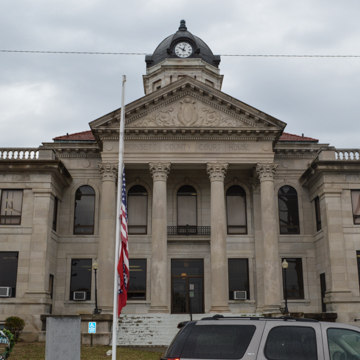The community of Bolivar, three miles to the north of Harrisburg, was the seat of Poinsett County until 1856, when it was determined that Harrisburg was more central and accessible for the county’s residents. The first courthouse burned in 1917, and Pine Bluff architect Selligman replaced it with this Classical Revival building. It is a large and impressive composition built during a period of prosperity for the town. The two-story building is set on a raised basement, is clad in gray Bedford stone, and is trimmed with sandstone. The north and south facades are identical, as are the east and west sides, where there are full-height pedimented porticoes, each with four Corinthian columns. A tall octagonal cupola supports a dome with a clock on all four faces.
You are here
Poinsett County Courthouse
If SAH Archipedia has been useful to you, please consider supporting it.
SAH Archipedia tells the story of the United States through its buildings, landscapes, and cities. This freely available resource empowers the public with authoritative knowledge that deepens their understanding and appreciation of the built environment. But the Society of Architectural Historians, which created SAH Archipedia with University of Virginia Press, needs your support to maintain the high-caliber research, writing, photography, cartography, editing, design, and programming that make SAH Archipedia a trusted online resource available to all who value the history of place, heritage tourism, and learning.











